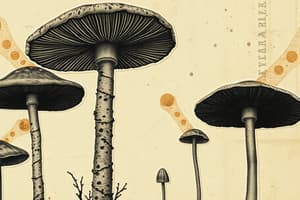Podcast
Questions and Answers
Which type of hyphae do Phycomycetes have?
Which type of hyphae do Phycomycetes have?
- Monocentric hyphae
- Coenocytic hyphae
- Septate hyphae
- Non-septate hyphae (correct)
Which group of fungi form sexual spores called ascospores in a sac?
Which group of fungi form sexual spores called ascospores in a sac?
- Basidiomycetes
- Fungi imperfecti
- Ascomycetes (correct)
- Phycomycetes
Which of the following statements accurately describes molds?
Which of the following statements accurately describes molds?
- They are multicellular and have threadlike tubular structures called hyphae (correct)
- They are unicellular and produce round pasty colonies on agar
- They form endogenous asexual spores within sporangia
- They reproduce by budding similar to yeast
Which of the following fungi are known for having septate hyphae?
Which of the following fungi are known for having septate hyphae?
What type of spores do Basidiomycetes reproduce by?
What type of spores do Basidiomycetes reproduce by?
What is a key characteristic of yeasts?
What is a key characteristic of yeasts?
Flashcards are hidden until you start studying
Study Notes
Systemic Classification of Fungi
- Phycomycetes: characterized by non-septate hyphae and production of endogenous asexual spores (sporangiospores) within sporangia, with oospore and zygospore as sexual spores.
- Ascomycetes: distinguished by formation of sexual spores (ascospores) in a sac called ascus, includes yeasts and filamentous fungi, and has septate hyphae.
- Basidiomycetes: reproduces through sexual reproduction, producing basidiospores at the tip of basidium, and has septate hyphae.
- Fungi imperfecti: a group of fungi where sexual phases have not been identified, including Sporothrix schenkii.
Structure and Reproduction of Fungi
- Fungi can be either unicellular or multicellular organisms.
- Yeasts: reproduce by a progenitor cell pinching off a portion of itself to produce a progeny cell, which may elongate to form sausage-like pseudohyphae, and produces round, pasty, or mucoid colonies on agar.
- Molds: multicellular organisms composed of threadlike tubular structures called hyphae, which elongate at their tips through apical extension.
- Hyphae: can be either coenocytic (hollow and multinucleate) or septate (divided by partitions or cross-walls).
Studying That Suits You
Use AI to generate personalized quizzes and flashcards to suit your learning preferences.




